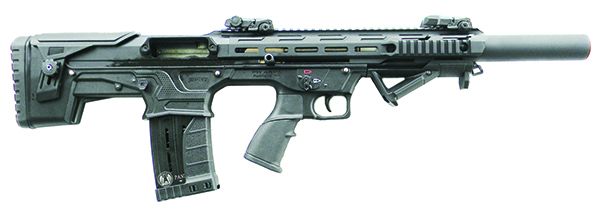GUN TESTS GRADE: C-
$650
This was a recent price from SportsmansOutdoor Superstore.com, but it’s currently listed as out of stock. The Panzer Arms BP-12 is an interesting shotgun that invited a great deal of debate. We test and get acquainted with a lot of shotguns. This is one is as different as it gets. So, we had to look at the shotgun on its own merits and also consider the pros and cons of a bullpup design.
| Action Type | Semi-auto, gas operated |
| Chamber | 3.0 in. |
| Overall length | 30.7 in. |
| Capacity | 5+1 |
| Weight | 7.8 lbs. |
| Weight loaded | 8.6 lbs. |
| Barrel Length | 20.0 in. |
| Finish | Blued |
| Choke Tubes | 3 |
| Stock | Fixed |
| Length of Pull | 16.5 in |
| Forend | Aluminum, w/rails |
| Sights | Picatinny top rail; AR-type aperture |
| Trigger Pull Weight | 11.0 lbs. |
| Safety | Ambidextrous HK type |
| Warranty | 1-year limited warranty |
| Telephone | (724) 590-1577 |
| Website | PanzerArmsUSA.com |
| Made In | Turkey |
An advantage of the bullpup is that it is a short shotgun with a full-length barrel. Accordingly, the shotgun handles quickly in close quarters. The center of gravity makes for a good balance. However, the shooter’s face is close to the chamber. We sometimes felt the blast of escaping gas on firing. Raters with long hair felt their hair blow about from this gas. This is disconcerting.
The center of gravity may make for better balance, but muzzle flip seems greater with a bullpup shotgun. This is probably because bullpup shotguns have the action and feed mechanism well behind the trigger. Also, the trigger featured a long drawbar to actuate the sear. The result is less reliability because the linkage may work loose. The Panzer Arms shotgun seems well made and robust, but the long linkage is simply part of the concern with bullpup shotguns. The trigger action was also heavy at 11 pounds on the Lyman digital scale.
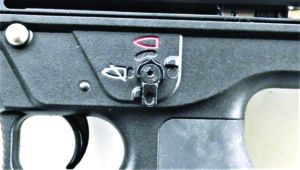
One of the raters compared the BP-12 to HK products, high praise. The machine work and welds were good, and there were no visible tool marks. The shotgun was supplied with a cleaning kit, a spare recoil ring for high-velocity loads, a set of iron sights, two five-round magazines, sling mounts, and an owners manual.
At first the shotgun may seem busy in layout, but the controls were well placed and the piece handles well. The shotgun featured ambidextrous safety levers. The safety was positive in operation. The bolt release and magazine release worked well. The cocking handle arrived mounted on the right side of the bolt. The bolt handle may be bumped out and changed to the other side. This is a good option. The shotgun’s grip was well designed and fit most hands well. The trigger guard allowed easy gloved-hand use. The stock featured a fore-grip design we don’t usually like, but this fore grip featured a stabilizing component ahead of the grip itself. This makes a positive difference in stabilization and control. The magazine release was on the right side. It was a considerable effort to learn to use the release quickly with a bullpup design. The bolt lock was on the left side and isn’t difficult to operate. Each control was positive in operation; it was the placement far back that took some effort to master. The Panzer BP-12 had plenty of room for mounting sights, red-dot sights, optics, and lights. The upper receiver and sides of the forend featured mounting areas. The magazines were metal with a polymer bracing component. We were favorably impressed with the magazine design. The bullpup design allowed the longest barrel of the test with a 20-inch length.
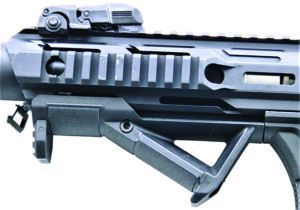
A couple of features were less impressive. The cheek riser must be removed to disassemble the shotgun. Disassembly was accomplished by removing the riser and unscrewing the barrel cover, then knocking three pins out and separating the upper and lower receiver. The receivers are then separated. Disassembly was straightforward. It wasn’t difficult to get the shotgun back together.
The BP-12 was supplied with three interchangeable choke tubes. AR-15-type sights were supplied that must be installed by the owner. During the firing test, we could not get our cheek low enough to properly aim with the aperture sights. In the end, we removed the cheek riser. We ended up using the sights with the rear peep in the middle of the rear sight folded down. This resulted in a nice broad sight picture. It took a while to figure this out. We tried a Burris Fast Fire 3 red-dot sight with good results as well, but did not use it extensively.
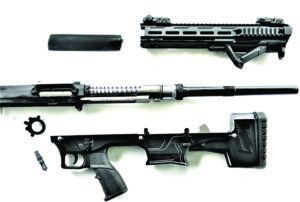
The primary drawback we isolated in dry fire was the trigger action. While tight and consistent, the trigger action was heavy at 11 pounds. Just the same, during combat drills, the shotgun’s trigger did not seem to be a drawback. Fire, recover from recoil, allow the trigger to reset, and fire again. The trigger wasn’t the best of the test, but it was not a complete washout. During firing, we found no sharp edges on the butt pad or grip. The shotgun exhibited modest recoil overall. However, the primary rater took a rap from the safety that produced a blood blister on his trigger finger just as the finger left the knuckle. This isn’t a good thing. It was very difficult to crook the finger around this safety lever.
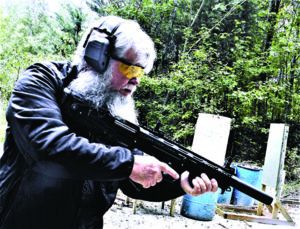
Panzer Arms cautions the shotgun needs a break-in period of two boxes of shells or so. A standard-velocity ring that fits in front of the recoil spring assembly was installed. A ring marked High Velocity was included in the box. We never installed the High Velocity ring. We collected a supply of shotgun shells for the test, intending to fire 50 buckshot shells in each shotgun. These included Fiocchi #00 buckshot, Federal TruBall slugs, Remington #4 Managed Recoil, and Federal 2¾-inch short Magnum 12-ball #00 buckshot. None functioned. All fired, but some fired and then did not eject. Some fired and the spent shell was caught in the ejection port. We dug up a box of Remington #000 shells. All functioned. We also had a good supply of Remington #00 buckshot delivered in. Each of these loads functioned properly. Was the shotgun broken in?
Returning to some of the other shells, we found that, no, the shotgun wasn’t broken in — it only worked with the Remington shells. We had decided to try a range of shells, but this did not occur because almost all of our initial choices did not function. Forty Remington #00 shells were fired without incident.
We also had difficulty with the sights. Firing with the rear sight folded down and using only the front post, the shotgun fired considerably high. We eventually figured out to remove the cheek riser and fold the center aperture down in the rear sight. This solved that problem. The BP-12 was fast on target. Recoil was straight to the rear and modest for a 12-gauge shogun. We managed to get five full-power Fiocchi Aero slugs together — some loads were difficult to find. The BP-12 fired about 4 inches low at 15 yards with slugs and sent five slugs into a 3-inch group. This was the only shotgun tested with a detachable magazine. A 10-round magazine is available but was not tested.
During the test, we changed the bolt handle to left-hand racking, and we found the shotgun fast to handle and make ready. Magazine swaps were not rapid in the sense that an AR-15 is, but they were plenty fast. The drill was to swing the muzzle up and to the rear as the non-dominant hand changed the magazine. The magazines seem to be made better than some we have encountered. We feel that the BP-12 demands more training and investment in time than the other shotguns. A considerable expense was involved in breaking the shotgun in and finding a load that functions. The Federal Short Magnum would be a strong load as an example, but it did not function. But different powders and loads produce different pressure curves. Each of the other shotguns functioned perfectly out of the box with the full range of loads. This was a major ding on the BP-12, our testers said.
Our Team Said: The Panzer Arms BP-12 was too finicky concerning reliability with certain loads. We found loads it liked, but after firing more than 80 shells, more than in the other shotguns, it still did not function with all full-power loads. In other words, it did not get broken in. This shotgun was aimed more like a rifle than pointed with the natural feel of a shotgun, which isn’t ideal, in our view. It was difficult to get into a proper position to use the supplied sights well. Because of the wide-ranging irritations, we would not buy this shotgun.



























